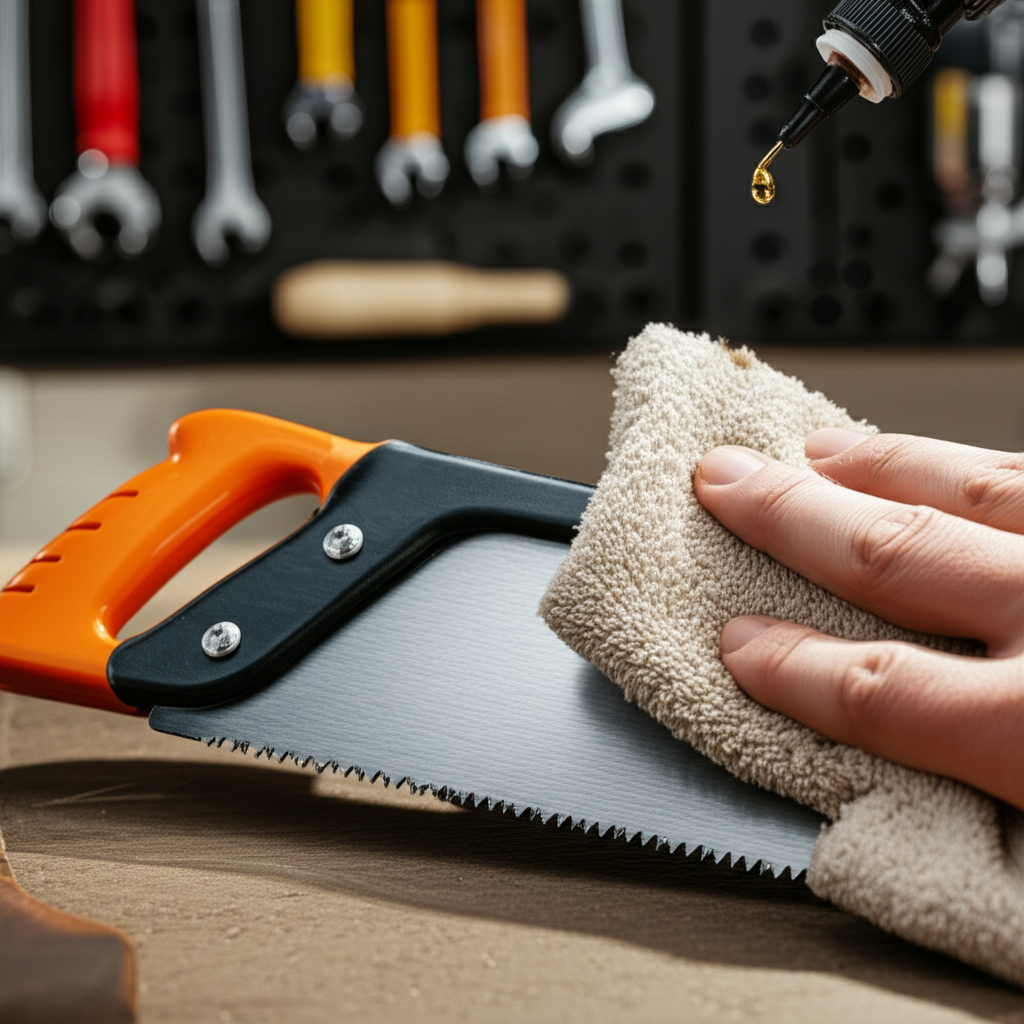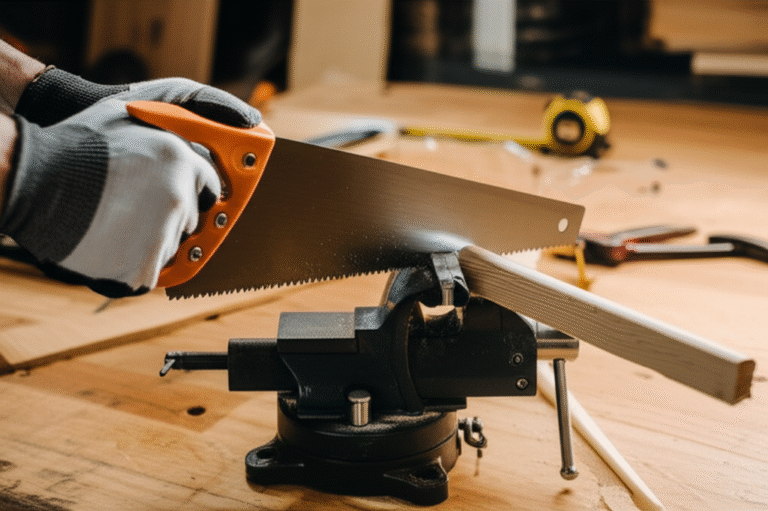Keep your hacksaw in top shape for cleaner cuts and a longer lifespan with these proven care tips. Learn how to clean, store, and maintain your hacksaw, including choosing the right blade and proper tensioning, to make every cut easier and safer.
Hey there, DIY friends! Samuel H. Murphy here from Capische. Ever grab your trusty hacksaw, ready to tackle that metal pipe or plastic trim, only to find it’s a bit… grimy? Or maybe the blade feels loose, and the cut isn’t as clean as you’d hoped? It’s a common frustration, but don’t worry! A little bit of care goes a long way in keeping your hacksaw ready for action. We’ll walk through simple, effective ways to maintain your hacksaw so it cuts like a dream, every time. Get ready to feel more confident and get better results on your projects!
Why Hacksaw Care Matters
Your hacksaw is a fantastic tool for cutting various materials like metal, plastic, and even some types of wood. But like any tool, it needs a little TLC to perform its best. Neglecting your hacksaw can lead to several issues:
- Dull Blades: A dirty or improperly stored blade will dull faster, making cuts harder and messier.
- Reduced Efficiency: A well-maintained hacksaw cuts faster and more accurately.
- Safety Hazards: A loose blade or a damaged frame can be dangerous to use.
- Shorter Lifespan: Proper care ensures your hacksaw lasts for many projects to come.
Think of it like taking care of your favorite kitchen knife. A little cleaning and sharpening make a world of difference. The same applies to your hacksaw!
Choosing the Right Hacksaw Blade
Before we dive into care, let’s talk about the heart of the hacksaw: the blade. The right blade for the job is crucial for both cutting performance and blade longevity. Hacksaw blades come in different lengths, tooth counts (TPI – Teeth Per Inch), and materials.
Hacksaw Blade Tooth Count (TPI)

The TPI tells you how many teeth are on one inch of the blade. This is super important for getting clean cuts and preventing the blade from getting jammed.
| Material to Cut | Recommended TPI | Why |
|---|---|---|
| Soft Metals (Aluminum, Copper) | 14-18 TPI | Fewer, larger teeth cut faster without clogging. |
| Medium Metals (Steel, Iron) | 18-24 TPI | A good balance for general metal cutting. |
| Hard Metals (Hardened Steel) | 24-32 TPI | More, finer teeth provide a smoother cut and prevent snagging. |
| Plastic | 18-24 TPI | Finer teeth prevent the plastic from melting or chipping. |
| Wood (if necessary) | 10-18 TPI | Larger teeth are better for wood, but a dedicated wood saw is usually preferred. |
Pro Tip: Always aim to have at least two or three teeth in contact with the material you’re cutting. If you’re cutting a thin piece of metal, use a higher TPI blade. For thicker stock, a lower TPI blade works better.
Blade Materials
Hacksaw blades are typically made from:
- High-Speed Steel (HSS): These are durable and can withstand higher temperatures, making them great for cutting harder metals.
- Bi-Metal: These blades combine a flexible spring steel back with HSS teeth. They are very durable and less likely to shatter, offering a good balance of flexibility and cutting power. This is often the best choice for general DIY use.
When you’re done cutting, don’t just toss the blade back in the toolbox. A little attention now means a better cut next time.
How to Properly Tension a Hacksaw Blade
Getting the blade tension just right is one of the most critical aspects of using a hacksaw effectively and safely. A blade that’s too loose will bend and break easily, and a blade that’s too tight can damage the frame or even snap the blade prematurely.
Step-by-Step Blade Tensioning:
- Select Your Blade: Make sure you have the correct TPI blade for the material you’re cutting.
- Insert the Blade: Place the blade into the hacksaw frame with the teeth facing away from you (towards the front of the saw). The hook or pin at the end of the blade should fit into the notch at the front of the frame, and the other end into the adjustable hook at the back.
- Tighten the Tension Knob: Most hacksaws have a wing nut or a tension knob at the back of the frame. Turn this knob to tighten the blade.
- Check the Tension: How do you know it’s tight enough? A good rule of thumb is to pluck the blade like a guitar string. It should produce a clear, high-pitched “ping” or “ring.” If it sounds dull or thud-like, it’s too loose. If it sounds strained or like it might snap, it’s too tight.
- Fine-Tune: Adjust the tension knob a little at a time, plucking the blade after each adjustment until you get that satisfying “ping.”
A properly tensioned blade will cut straight and true, and it’s less likely to break. You can find more information on tool tensioning and best practices from resources like Popular Mechanics, which offers great practical advice for DIYers.
Cleaning Your Hacksaw
After each use, especially if you’ve been cutting metal, your hacksaw will likely have metal shavings and dust on it. Cleaning it is simple but makes a big difference.
Tools You’ll Need:
- Stiff brush (a wire brush or an old toothbrush works well)
- Clean, dry rags
- Optional: Light oil (like 3-in-One oil or WD-40)
Cleaning Steps:
- Brush Away Debris: Use your stiff brush to thoroughly brush away any metal filings or dust from the blade, the frame, and the handle. Pay attention to the teeth of the blade and the area where the blade mounts to the frame.
- Wipe Down: Use a clean, dry rag to wipe down the entire hacksaw. This removes any remaining dust and can help prevent rust.
- Blade Care (Optional but Recommended): For metal cutting, a very light coating of oil on the blade can help prevent rust and keep it gliding smoothly. Apply a tiny amount to a rag and wipe the blade down. Make sure to wipe off any excess oil before your next use, as too much oil can make the blade slip.
- Frame and Handle: Ensure the frame and handle are clean and dry. If the handle is plastic, a damp cloth can be used if needed, but make sure it’s dried thoroughly.
Don’t forget to clean the blade slot where it attaches to the frame. This area can accumulate grime that might interfere with proper blade seating.
Storing Your Hacksaw
Proper storage is key to preventing damage and keeping your hacksaw in good condition. You don’t want your hacksaw blade getting bent or dulled by bumping against other tools.
Storage Best Practices:
- Blade Protection: If possible, remove the blade after use and store it separately in its original packaging or a blade protector. This prevents accidental cuts and protects the teeth.
- Keep it Dry: Moisture is the enemy of metal tools. Store your hacksaw in a dry environment, like a toolbox, workshop, or garage that isn’t prone to dampness.
- Organized Storage: Don’t just toss your hacksaw into a pile of tools. Keep it in a designated spot where it won’t be crushed or damaged. Tool racks, pegboards, or dedicated slots in a toolbox are ideal.
- Blade Tension: It’s generally recommended to loosen the blade tension slightly when storing the hacksaw for extended periods. This relieves stress on the frame and the blade.
Think about how you store your knives or other sharp tools. The same principles apply to keeping your hacksaw safe and functional.
When to Replace a Hacksaw Blade
Even with the best care, hacksaw blades wear out. Knowing when it’s time for a new one will save you a lot of frustration and effort.
Signs It’s Time for a New Blade:
- Slow Cutting: If you’re really having to push hard and the material isn’t cutting easily, the blade is likely dull.
- Rough or Jagged Cuts: A dull blade will leave a rough edge, rather than a clean one.
- Blade Bending or Snapping: While this can sometimes be due to improper tension or technique, a blade that repeatedly bends or breaks might be fatigued or simply worn out.
- Missing Teeth: If you notice several teeth are broken or missing along the blade, it’s time for a replacement.
Replacing a blade is easy and will instantly improve your cutting experience. You can find a wide variety of replacement hacksaw blades at most hardware stores and online retailers.
Hacksaw Maintenance Checklist
Here’s a quick rundown to help you remember what to do:
| Task | Frequency | Notes |
|---|---|---|
| Brush off debris | After every use | Focus on blade teeth and frame. |
| Wipe down | After every use | Use a dry rag. |
| Lightly oil blade (optional) | After cutting metal, before storage | Prevents rust, use sparingly. |
| Check blade tension | Before each use | Listen for the “ping.” |
| Loosen blade tension | For long-term storage | Reduces stress. |
| Inspect for damage | Periodically | Frame, handle, and blade condition. |
| Replace dull blades | As needed | Don’t force a dull blade. |
Keeping up with these simple steps ensures your hacksaw is always ready to perform. For more in-depth information on tool maintenance, resources like This Old House often share valuable tips.
Frequently Asked Questions (FAQ)
Q1: How tight should a hacksaw blade be?
A1: A hacksaw blade should be tensioned so that when plucked like a guitar string, it produces a clear, high-pitched “ping” or “ring.” It shouldn’t sound dull or thud-like, nor should it sound like it’s about to snap.
Q2: Can I use a hacksaw for wood?
A2: While you can cut wood with a hacksaw, it’s not ideal. Hacksaw blades have fine teeth designed for metal, which can clog easily in wood. If you need to cut wood regularly, a handsaw or a power saw designed for wood will give you much better results and a cleaner cut.
Q3: How do I prevent my hacksaw blade from breaking?
A3: Ensure the blade is properly tensioned, use the correct TPI for the material, and maintain a consistent, steady stroke. Avoid twisting or forcing the blade. Let the teeth do the work.
Q4: What is the best way to clean a hacksaw after cutting metal?
A4: Use a stiff brush to remove metal shavings. Then, wipe the blade and frame with a dry rag. For rust prevention, you can apply a very light coat of oil to the blade with a rag, wiping off any excess.
Q5: How often should I replace my hacksaw blade?
A5: Replace your hacksaw blade when it becomes dull, cuts slowly, or produces rough edges. This depends on how often you use it and the materials you cut, but typically a blade lasts for many projects if used correctly.
Q6: Can I use a power tool for hacksaw tasks?
A6: For many cutting tasks, power tools like reciprocating saws (Sawzalls) or angle grinders can be used. However, for precise cuts on smaller pieces or in tight spaces, a manual hacksaw is often more controllable and safer for beginners. Always follow safety guidelines for any tool you use.
Conclusion
There you have it! Caring for your hacksaw is straightforward and incredibly rewarding. By paying attention to blade selection, proper tensioning, regular cleaning, and smart storage, you’re not just extending the life of your tool – you’re ensuring every cut you make is cleaner, faster, and safer. No more struggling with dull blades or frustratingly crooked lines. You’ve got the knowledge to keep your hacksaw in prime condition for all your DIY adventures. So go ahead, grab your well-maintained hacksaw, and tackle that next project with confidence!
